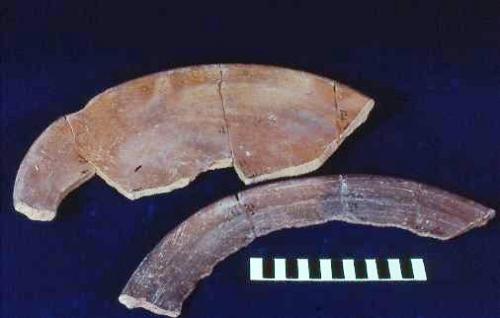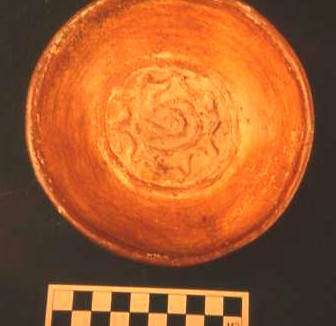Momoxpan Metallic Orange
Momoxpan Metallic Orange is characterized by a semi-lustrous surface finish that, through burnishing and firing technique, occasionally acquires a metallic appearance. It is primarily a utilitarian ware, usually occurring as comales, but serving ware bowls are also present.
Paste and Firing Effects
This type has a fine to medium grain paste. Vessels are well-fired to a moderate to brittle hardness. The paste is tan to light reddish brown in color, with occasional dark gray firing cores. Fire clouding is common, giving the exterior surface its characteristic "metallic" luster.
Surface Treatment
Vessels are usually burnished and slipped, with a light reddish- orange color. Comales are burnished on the interior, but the exterior is characteristically very rough except around the edge, which is wiped. Cajetes are burnished on both the interior and exterior. The surface is often irregular, with lumps and scratches in the finish.
Decoration
Other than the slip and characteristic fire clouds, this type is undecorated. Some comales have a distinctive checkerboard burnishing pattern on the interior surface, but this is probably a result of the burnishing technique, perhaps from the use of a corncob.
Vessel Forms
Although the type is found in both utilitarian and serving wares, the most numerous form is the comal, at 87% of the type total (Table 5). Comales range in diameter from 37 to 41 cm, with a vessel height between 1.5 to 4.5 cm (Fig. 1). Vessel wall thickness varies based on distance from the rim, with the interior base often very thin (3 to 5 mm). Rim forms vary, but can generally be described as bolstered, often with a flange on the exterior. An interior ridge, about 1 cm below the rim, is also common. Analysis of the UA-1 materials did not identify a consistent pattern in rim form, and large vessel fragments display variation in rim form on the same piece.

Figure 1: Momoxpan Metallic Orange comales
Other vessel forms that occur in low frequencies include subhemispherical and conical bowls. Subhemispherical bowls measure 14 to 17 cm in diameter, and 3 to 4 cm in height. Conical bowls range from 14 to 24 cm in diameter, and about 5 to 10 cm in height (Fig. 2). Conical bowls may have either a direct or slightly flaring rim.


Figure 2: Momoxpan Metallic Orange subhemispherical bown with stamp bottom design
Miniature bowls were a minor form in the UA-1 assemblage. They measure about 10 cm in diameter and 3 to 4 cm in height. These may have been used as spinning bowls during supported spinning; Suárez C. (1989) reports numerous miniature Momoxpan Orange bowls from a mass burial in San Andrés Cholula that was possibly associated with a Late Postclassic weaving compound (McCafferty 1992b).
Discussion
Momoxpan Metallic Orange is one of the most important components of the Postclassic Cholula ceramic complex, and one which shows remarkably little variation throughout the Postclassic period. Its principle vessel type, the comal, is indicative of heating tortillas, an activity that is known ethnohistorically to have occurred within the household compound. The presence of comal fragments can therefore be used to infer domestic activities.
This type has been identified in previous studies of Cholula pottery. Noguera (1954:73-74) and Müller (1978:111) describe the comal form, both pointing out the "metallic" appearance. Peterson termed this "Tecpanecatl Orange" in his MA thesis (1972), and Mountjoy and Peterson (1973) identified it as "Román Orange." It was present in moderate to high frequencies in Postclassic assemblages from the UDLA campus (Mountjoy and Peterson 1973:81, Table 8).
In the typology developed by Lind and his students (Caskey and Lind n.d.), the term "Momoxpan Orange" was used to identify the cajetes, while "Román Orange" identified comales. In the Late Postclassic F-10 trash midden at UA-79 (Barrientos 1980), "Román Orange" comales made up 13% (n=518) of the assemblage, while "Momoxpan Orange" cajetes accounted for another 6% (n=255), for a total of 19% of the total midden assemblage.
In the UA-1 typology I have grouped both of these vessel forms into the Momoxpan Metallic Orange type, based on the shared attributes of burnished orange slip and frequent "metallic" fire clouds. Momoxpan Orange made up 19.6% of the total assemblage, and was present in moderate to high frequencies in all four of the primary contexts. In the assemblage as a whole, comales made up about 87% of the type total. This frequency is relatively consistent between the different depositional contexts. Cajetes, especially conical bowls, were most numerous in the Trash Midden, but even there they were much less abundant than in the UA-79 midden deposit.
Momoxpan Orange was present as only a trace in the R-106 subfloor deposits, suggesting that it was not a significant component of the Classic period ceramic complex (McCafferty 1996a). At the Patio of the Carved Skulls, Momoxpan Orange was present in low frequency, and exclusively as comales. Since comales were relatively rare in this Early Tlachihualtepetl assemblage the low amount of Momoxpan Orange could be the result of the specialized context of this elite residential complex, but I suspect that it was also because it was an early stage in the development of the Postclassic ceramic complex. Thus the Patio of the Carved Skulls assemblage represents a transitional point between the Classic and Postclassic patterns, and the use of comales as a method for preparing tortillas was a relatively new innovation.

